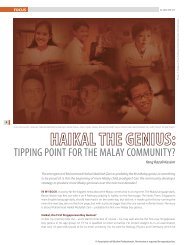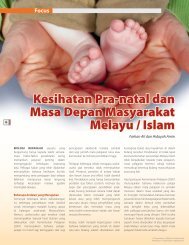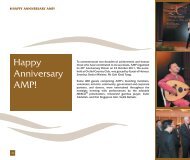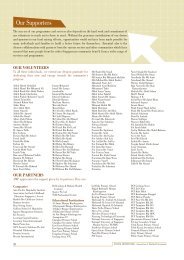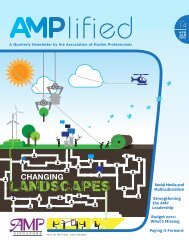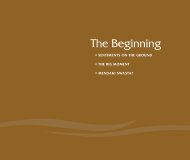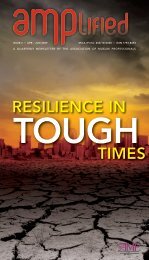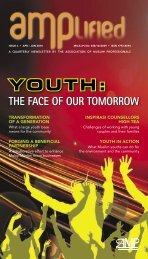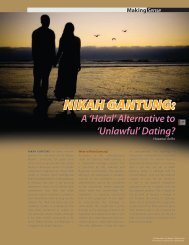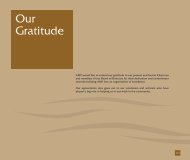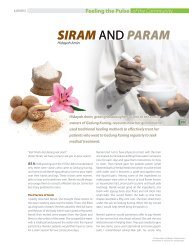The AMLA Amendments - Association of Muslim Professionals
The AMLA Amendments - Association of Muslim Professionals
The AMLA Amendments - Association of Muslim Professionals
Create successful ePaper yourself
Turn your PDF publications into a flip-book with our unique Google optimized e-Paper software.
KARYAWAN Issues / Community Pioneering Malay Entrepreneurs<br />
‘Haji Yus<strong>of</strong>f was a very thrifty man and invested his pr<strong>of</strong>its in real estate. He bought houses<br />
and lands in various parts <strong>of</strong> Singapore such as Selegie Road, Middle Road, Serangoon<br />
Road, Arab Street, Malabar Street, Kallang Road, Joo Chiat Road and Kandahar Street.’<br />
Haji Yus<strong>of</strong>f’s father, Haji Mohamed Noor Bin Haji Ali was born in Solo in Java, Indonesia. Sometime in the mid 1850s, he<br />
stopped in Singapore on his return trip from pilgrimage to Mecca. While in Singapore, he noticed a wealth <strong>of</strong> trading<br />
opportunities in this growing seaport. Haji Mohamed Noor decided that he would strike his fortunes there and set up his<br />
home in a hut in Kandahar Street, running a food stall in Rochor.<br />
Around 1853, Haji Mohamed Noor married Kamsinah, a woman <strong>of</strong> Javanese descent. Haji Yus<strong>of</strong>f was born in 1855. He<br />
studied in a religious class at the Sultan Mosque and studied Malay at home. Haji Mohamed Noor did not allow Haji Yus<strong>of</strong>f<br />
to go into the food business so his 22 year old son started the songkok (Malay traditional cap for men) business. Haji Yus<strong>of</strong>f<br />
then decided to specialise in the tali pinggang (belt) business upon his return from pilgrimage in 1885.<br />
Haji Yus<strong>of</strong>f became an expert in the business <strong>of</strong> tali pinggang and songkok. His tali pinggang and songkok could be found<br />
in all stores selling such items. His goods were in high demand especially during the Haj season when pilgrims en route to<br />
Mecca would stop in Singapore and buy his products. His tali pinggang trademark was that <strong>of</strong> a crocodile and elephant,<br />
each <strong>of</strong> the two standing on either side and pulling the belt between them.<br />
He monopolised the tali pinggang and songkok market in Singapore and was also the main importer and exporter for<br />
these goods. He was thus known as Haji Yus<strong>of</strong>f ‘Tali Pinggang’ – Haji Yus<strong>of</strong>f the Belt Merchant. His tali pinggang and<br />
songkok were exported to Mindanao in the Philippines, Brunei, Miri, Sarawak, Johore, Penang, and the islands in the<br />
Malay Archipelago such as Siak, Bengkalis, Mentok, Sulawesi, Bugis and Palembang.<br />
Haji Yus<strong>of</strong>f was a very thrifty man and invested his pr<strong>of</strong>its in real estate. He bought houses and lands in various parts <strong>of</strong><br />
Singapore such as Selegie Road, Middle Road, Serangoon Road, Arab Street, Malabar Street, Kallang Road, Joo Chiat Road<br />
and Kandahar Street. He also had some properties in Malaya, namely in Batu Pahat and Penang. Besides those properties,<br />
Haji Yus<strong>of</strong>f owned rubber, coconut and palm plantations in Changi and about 100 hectares <strong>of</strong> palm plantation in Batu<br />
Pahat. His prized possession must be Gedung Kuning which he purchased on July 30th, 1912.<br />
35<br />
Hidup kayu berbuah, hidup manusia berjasa<br />
(Just as a tree bears fruits, a man lives to benefit others)<br />
Although Haji Yus<strong>of</strong>f was busy with his business, he made time to serve the Malay/<strong>Muslim</strong> community. He was a nazir<br />
(Management Committee member) <strong>of</strong> the Sultan Mosque for 30 years from 1914 to 1944. As a nazir, he was responsible for<br />
raising funds for the mosque and looked after the development <strong>of</strong> the mosque. <strong>The</strong> mosque was looking for a trustworthy<br />
businessman who would safeguard the mosque’s funds. Since Haji Yus<strong>of</strong>f was the only one among the community leaders<br />
who had a cheque book and a bank account at the time, he was entrusted with this responsibility.<br />
Haji Yus<strong>of</strong>f started a free madrasah (Islamic school) in a room on the first floor <strong>of</strong> the Sultan Mosque, which he named after<br />
his father. Madrasah Haji Mohamed Noor functioned for more than 10 years before it ceased its operations when Singapore<br />
was occupied by the Japanese in 1942. <strong>The</strong> madrasah’s tarbus (Moroccan Fez hat)-wearing teacher, Ustaz Jaafar, was later<br />
appointed by the Japanese to become the Governor <strong>of</strong> Sumatra.<br />
Haji Yus<strong>of</strong>f also held the haul (completion <strong>of</strong> one year) ceremony annually at Gedung Kuning. <strong>The</strong> haul ceremony was<br />
to commemorate the death anniversary <strong>of</strong> his ancestors and foster community bonding. <strong>The</strong> gates <strong>of</strong> Gedung Kuning<br />
never turned away anyone. Widows and orphans <strong>of</strong>ten came to the house to ask for zakat (alms). And for the poor who<br />
did not get the chance to go to Gedung Kuning, Haji Yus<strong>of</strong>f’s will provided funds for two mosques to prepare food for<br />
them during the fasting month <strong>of</strong> Ramadan.<br />
Haji Yus<strong>of</strong>f could be considered as one <strong>of</strong> the wealthiest Singaporeans <strong>of</strong> his time but he remained humble, choosing not to<br />
flaunt his wealth. Some wealthy philanthropists had roads, buildings, hospitals, gardens named after them, but not Haji Yus<strong>of</strong>f. He<br />
chose to contribute to the local community the best way he knew – quietly. My father <strong>of</strong>ten said, “What the right hand gives, the<br />
left hand must not know.” I suppose Haji Yus<strong>of</strong>f lived up to that saying, preferring God’s blessings to human praises.



